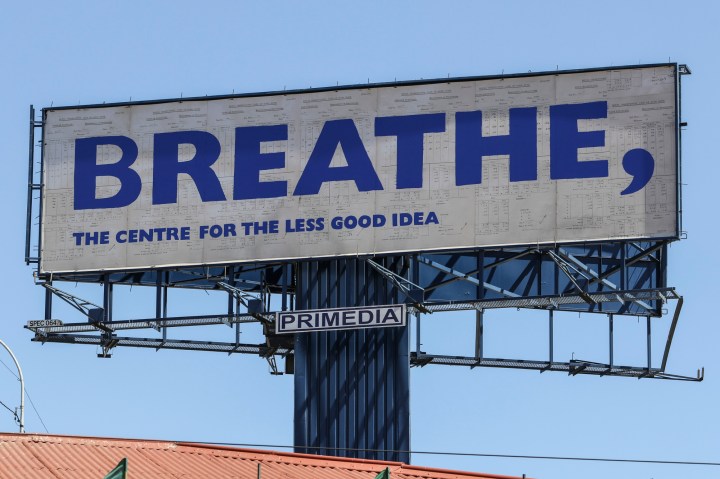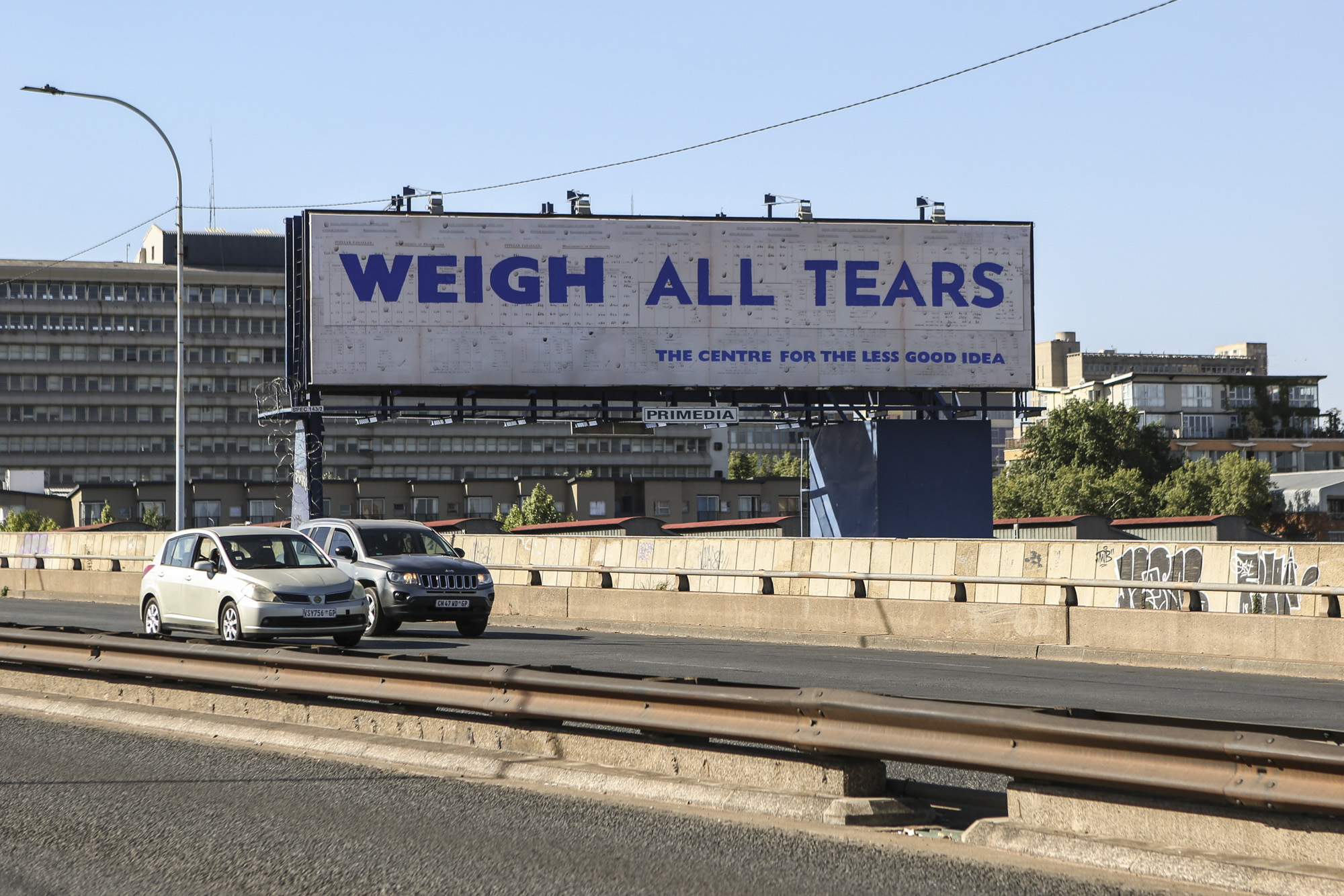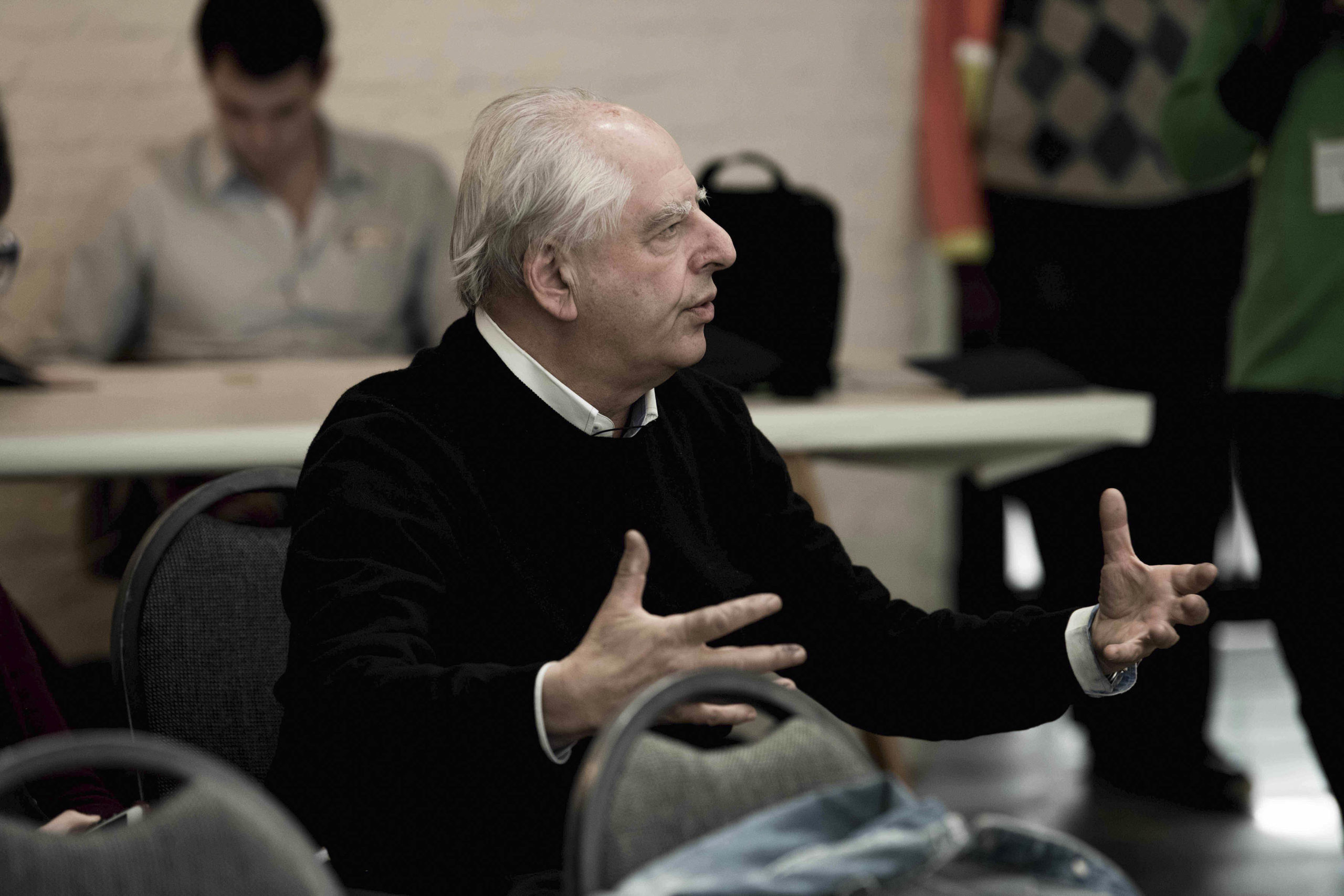NEW FRAME
Billboard art makes the questions bigger

A team of artists and poets are annexing Johannesburg’s roadside distractions in a project curated by the Centre for the Less Good Idea.
This story was first published in New Frame.
Right now, there is a billboard overlooking Johannesburg’s M1 highway bearing an instruction: “WEIGH ALL TEARS”. Another one, on the M2, reads “BREATHE”.
These two messages are arguably bossier than most billboard adverts, but they feel impossible to obey. We cannot feasibly measure the mass of human sorrow. And the pandemic is relentlessly choking our prior hopes and certainties, if it isn’t choking our lungs.
Both images were made by William Kentridge, the globally renowned Johannesburg artist and founder of the Centre for the Less Good Idea, as the pilot for a series of billboard images created by a group of South African artists and poets. Funded by Kentridge, the centre is a laboratory for a radically lateral, rhizomatic strategy for making visual art, theatre and dance as well as mixtures of the three forms. The Highway Notice Project is a way for the centre’s experimental creative collaborations to move beyond the digital terrain of pandemic-era arts, while also avoiding the risks of physical gatherings.
In due course, electronic billboards could be added, echoing the Minutes to Midnight project in Times Square, New York, in which a roster of artists, including Kentridge, have taken over the square’s sea of digital billboards.
Project curator Bronwyn Lace invited 10 artists and writers to contribute to the Johannesburg project. These include poet and playwright Koleka Putuma, storyteller and sociologist Upile Chisala, graphic artist Sindiso Nyoni (aka R!OT) and visual artist Oratile Konopi.

Undated: The first set of billboards on the M2 highway are the pilot for a series of images created by a group of South African artists and poets, including Koleka Putuma and Oratile Papi Konopi. Photograh by Zivanai Matangi
The contributors will take turns to prod the minds of Joburgers from the heights of the M1 and M2 billboard frames, which the centre has reserved till March next year. While they cannot reveal too much about their various plans, Putuma says she is relishing the chance to intervene in the traditionally vacuous territory of corporate brands.
“The opportunity with this project is that we can be more intentional and relevant than advertising is about what we want you to see, or engage with, beyond the image.” When invited to participate, Putuma immediately resolved to confront the crisis of gender-based violence. “For the last couple of months, I have been really hung up on the fact that every three hours a woman is murdered in South Africa. So I will do something that will make people think, every other second, about the gravity of that statistic.”
Putuma says cityscapes steer the inner lives of their inhabitants in both obvious and subtle ways, and sees this project as a way of revealing and destabilising those effects.
“The legacy of apartheid spatial planning is that our urban spaces were designed to make certain groups move in particular ways, for example, the time it took someone to get from the CBD to a township, and still does. That impacts everything in our society, to this day. We do not engage in public spaces by choice, though we may think that on some level we choose to do so. There is a predesigned quality that controls. It is profound that artists can occupy these spaces, especially at a time where we are deemed non-essential workers. Even if 5% of the people who see the work will know that an artist took the time to make it, that is powerful.”
The aesthetic freedom of the project is particularly thrilling for Nyoni, who has created many commercial images – billboards among them – and knows the pathologies of the advertising industry inside out. “My gripe has always been about outdoor advertising moving toward visual pollution. Brands plastering their stuff all over the place, persuading you to buy something you don’t need. The irony is that centuries ago, advertisers used to commission amazing signwriters and artists. I’m very familiar with working on both sides of the fence, but I’ve always been very selective about what I associate myself with.”
Konopi is also highly qualified when it comes to billboards, being a Soweto-raised, University of the Witwatersrand-trained artist who explores the social and ideological power of language and media imagery. His piece goes up in November and will form part of his series of works under the collective title Bua Le Ênê (“talk to them” in Setswana).
“Mine is a text-based work in parallel with a much larger practice investigating the complexities of speech and gender, and the construction of black masculinities in particular.
“The phrase bua le ênê uses a genderless pronoun, meaning the person being spoken to could be anyone. It’s about really asking the observer, who is speaking these words, and who is being referred to?”
Konopi is fascinated by the gender-neutral syntaxes of indigenous South African languages. “A lot of South African languages don’t gender the pronoun, you have an understanding of the gender of the person referred to from the context. That also happens with naming practices.”
He had already been playing with analogue mass-media aesthetics in the form of tabloid newspaper posters. “So many people are intimidated by ‘fine art’, it is usually far removed from their experience and language. So I’ve started adopting popular cultural forms to create multiple points of access. The quotes in the headlines activate nostalgia for an oral history, words that have been said or shouted and not necessarily written. It’s about archiving these things that have been said. How do we remember them, and how do we reimagine them?”
The combination of the scale and transience of a billboard sighting intrigues Konopi. “It asks for a different way of engaging, a fleeting moment of movement that becomes a memory to encounter or physically revisit.”
A patron of paradox
The billboard project is just one of dozens of similarly experimental projects hosted and curated by the Centre for the Less Good Idea.
Kentridge describes the centre’s guiding practice as follows: “Often, you start with a good idea. It seems crystal clear at first, but when you take it off the proverbial drawing board, cracks and fissures emerge, and they cannot be ignored. It is the process of following the secondary ideas, those ‘less good ideas’ coined to address the first idea’s cracks, that the centre nurtures, arguing that in the act of playing with an idea, you can recognise those things you didn’t know in advance but knew somewhere inside of you.”
In an interview, Kentridge said the centre’s lack of bureaucratic procedure is central to its ethos and its potential. “For one thing, until now, we’ve never had to report back to anyone. We have not up until now done fundraising. It doesn’t work with committees. The curators of each season are responsible for choosing an interesting programme of work rather than the decisions being made by a constituted committee. So nobody ever has to write a proposal. It’s an ongoing conversation that happens. Now that it’s constituted as a legal, not-for-profit organisation, there’s greater accountancy and auditing to keep on track, but it’s still relatively simple.”
There is an effort at the centre to talk and write about art in a more lucid, accessible mode than that of academic art theory. “The nature of the academy we’re trying to start is not a rebuke to the universities, but it’s a very different way of thinking about art. Thinking in material. Letting the idea follow the impulse.”
While in one sense Kentridge performs the traditional role of patron, he also sees the centre as a place for his own creative progress. “It’s both a project for other people and for myself,” he says. It’s a way of expanding on the way I’ve worked on my own projects, and showing other artists, musicians and directors ways of working that are quite loose and open-ended and seeing what emerges. And a way of keeping in touch with a new generation, hearing new thoughts, seeing new work.”
The project includes a series of lectures and workshops by leading artists called the So Academy, and a fascinating series of one-minute Instagram films called the Long Minute. Every performative process that happens at the centre, including rehearsals, is filmed and archived.
2020 has been an oddly positive year for Kentridge, with his usual frenetic diary giving way to uninterrupted art-making. But he is aware that a year defined by cancellations of performances and projects has been extremely stressful for his collaborators.
“I’m very aware that for all the people I work with, the actors, the dancers, the designers, it’s been calamitous. They’ve just had no income this year. And not only that, but no means of practising their metier.
“For a while we’ve been having rehearsals in the centre, even though we can’t do performances yet. We start in a month’s time, on a very small scale. Maybe 20 or 30 people watching works in progress. And we hope that by March next year we can have a season again.”
The dangers of certainty
Kentridge is unsettled by the decline of traditional art institutions, such as the Johannesburg Art Gallery, and the financial pressures on academic art training. But he notes that independent bodies have always been the most fertile scenes of South African artistic innovation, mentioning the Space Theatre in Cape Town, the early Market Theatre, Dorkay House, the Serpent Players and the Johannesburg Art Foundation. The lack of a higher authority – financial and intellectual – is a potent condition, he says, and the centre is no exception.
“The whole centre has a kind of a deep polemic about the dangers of certainty, the authoritarian element that comes with all ideas that have a claim to certainty. Because there are such paradoxes and ambiguities inherent in the way the world operates, that to try to cut those out and say this is the solution, can only be done when supported by a force or a pressure, whether it’s a loudness of a voice shouting or a stronger imperative behind that. So that’s about art-making, but also about politics. It’s about taking the absurd and the paradoxical into the centre, instead of saying it’s an amusing thing at the edge. And I suppose the centre is a long-term test of those ideas.”

Undated: Artist William Kentridge founded the Centre for the Less Good Idea, which curates experimental work such as the Highway Notice Project.
He refuses to predict its future. “I hope it continues, but it doesn’t have to be about longevity. If it’s a six or eight-year project that runs out of steam, that’s fine. And if it becomes something different, that’s also good.”
Truly free lines can’t be led, they have to be followed. DM/ ML


















 Become an Insider
Become an Insider
We need artists and thinkers more than ever before. We need to Breathe as we Weigh All Tears. Historically, Artists have always been instrumental to social enlightenment and ultimate change. If ever there was a time… it has to be now. Here.
This is excellent. Thank you for highlighting the project.